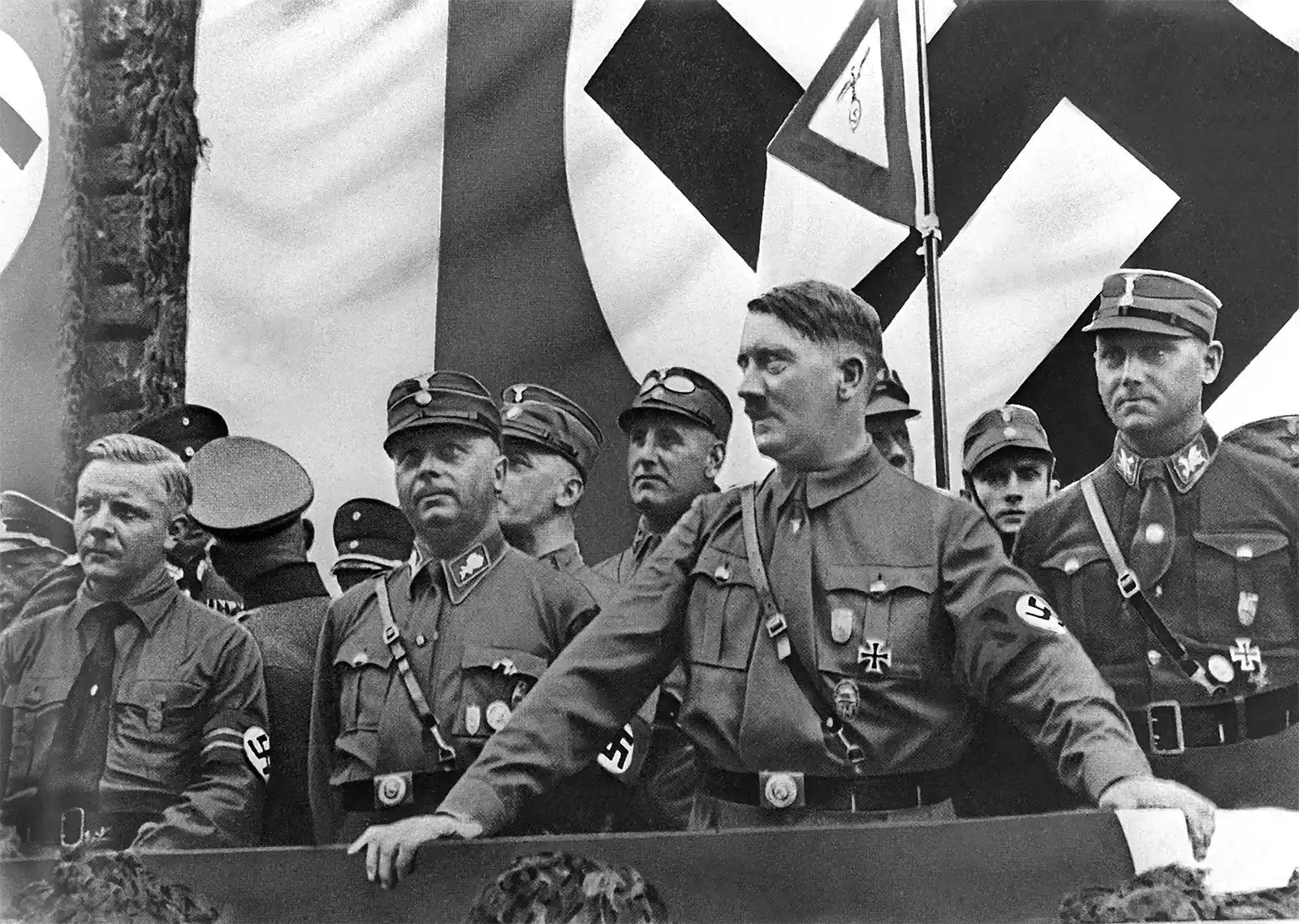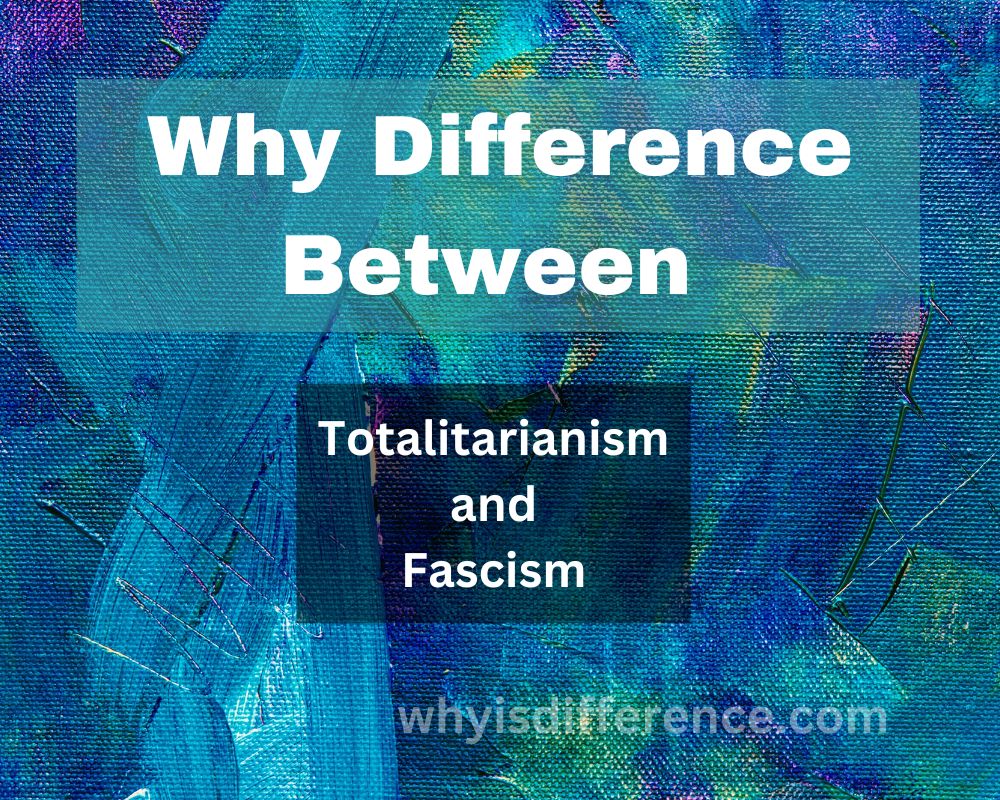Totalitarianism and Fascism: Totalitarianism, fascism and other ideologies can be found throughout the world in various forms. From capitalism to fascism to communism and totalitarianism - each has their own place and history of influence on how it should be practiced today - after the break-up of Soviet Union these ideologies have faded as society mixes old with new beliefs; today most ideologies represent an amalgam of various past ideologies; herein this article we aim to discuss two such ideologies; totalitarianism vs fascism; discussing their respective differences within and history
What is Totalitarianism?

Totalitarianism refers to any system in which the state exerts absolute power over every aspect of private and public life - including finances, politics, socio-cultural beliefs systems and attitudes and morals. Totalitarianism was popularly coined by Italian fascists during the 1920s. Italian fascists attempted to interpret totalitarianism positively by emphasizing its "positive goals" toward society improvement. A totalitarian regime can be identified by its national ideology, whether implicit or explicit, providing its society with direction and purpose.
Totalitarian regimes feature many key characteristics, including an authoritarian leader enforcing laws, one political party with total state control, mandatory military service for all citizens, prohibition of religious practice or joining political groups critical of the government, as well as enforcement by secret police or military forces. All these features aim to instill fear in its citizens about their government. Two such regimes were Germany under Adolf Hitler and Italy under Benito Mussolini - two extreme examples.
What is Fascism?

Fascism is a form of authoritarianism with elements of totalitarianism that has gained less prominence since 1945, though still identifiable through elements like dictatorial rule, state control over commerce and industry, the violent suppression of opposing parties with force, laws enforced either through secret police or military forces and so forth.
History of Totalitarianism
The rise of different regimes seeking absolute control of every aspect of society marked the history of totalitarianism. Here is a short overview of key events and examples from its development.
- Joseph Stalin led the Soviet Union from 1924-1953: after Vladimir Lenin had passed. Under Stalin's regime were widespread famines, purges, forced labor camps, as well as strict state control and an emphasis on personality cultism over all aspects of Soviet life.
- Adolf Hitler and Nazi Germany came to power jointly in 1933 : when Adolf Hitler led his Nazi Party and Germany. Hitler instituted a fascist government which combined anti-Semitism, militarism and Aryan supremacism with extreme nationalism; these ideals led them to centralize power while suppressing opposition and persecuting millions during the Holocaust, including Jews and Romani people as well as disabled individuals, political dissidents, dissidents, political dissidents etc; their aggressive actions led them straight into World War II.
- Fascist Italy Under Benito Mussolini, 1922-1943: Benito Mussolini founded the National Fascist Party and later served as Prime Minister in Italy from 1922-1943. His fascist regime focused on restoring Rome's glory while creating a totalitarian regime with high values for nationalism, militarism and suppression of any opposition; corporatist policies were employed within the economy and control was centralized across various aspects of society - until his exit due to both World War II participation as well as internal discontent from these factors in 1943.
- North Korea under the Kim Dynasty (1948-2010) After World War II: the Korean Peninsula was devastated and the Democratic People's Republic of Korea (DPRK) was established under Kim Il Sung as its leader. Kim Il-sung instituted a totalitarian regime that heavily centralized power, instituted a cult of personality and suppressed any forms of dissent - a regime continued by Kim Jong Il and then Kim Jong Un who both continued this authoritarian system with severe human rights violations against them both being hallmarks of DPRK dictatorship.
- Other Examples: Totalitarian governments exist across the world. One notable instance was Cambodia during Pol Pot's Khmer Rouge regime from 1975-1979 when millions were murdered during what became known as Cambodian Genocide. Other nations like China experienced totalitarian regimes during Great Leap Forward and Cultural Revolution from 1966-1976 led by Mao Zedong.
Totalitarianism's history can vary significantly by country and context. By understanding it better, one can gain greater insight into extremist ideologies' dangers while protecting democratic values and individual liberties.
History of Fascism
Fascism emerged as a political movement in the early twentieth century and rapidly gained ground during the interwar years.
Here is a brief history of fascism with its most important events and examples highlighted:
- Benito Mussolini (1922-1943) : Benito Mussolini rose to power as Italy's fascist leader from 1922-1943. He established the National Fascist Party and created the Fascist Italian State. Under him was extreme nationalism, militarism and authoritarianism which stressed authoritarianism while suppressing political opposition. Mussolini attempted to restore Rome's glory while centralizing power through corporatism before eventually being overthrown by Allies during World War II resulting in his being executed.
- Adolf Hitler and the National Socialist German Workers' Party: commonly referred to as the Nazi Party, came to power in Germany in 1933 under Adolf Hitler. Their radical regime combined Aryan ideologies, anti-Semitism militarism and totalitarianism; Nazi ideology was spread widely while they created a Hitler cult and pursued aggressive policies of expansion; these events ultimately lead to World War II with Nazi Germany ultimately being defeated and defeat.
- Spain under Francisco Franco: 1939 to 1975- In 1936, Francisco Franco led an uprising against the democratic Spanish Republic which led to a Civil War between Nationalist forces supported by Italy and Nazi Germany and Nationalist forces supported by fascist Italy and Nazi Germany vying for control of Spain under a dictatorship known as Francoist Spain which consisted of authoritarian rules suppressing political dissension as well as nationalist and conservative ideologies; his regime would last until his death in 1975 and was then transformed into constitutional monarchy by his successors transforming Franco's dictatorship into constitutional monarchy once again.
- Fascist movements: regimes and movements also emerged across Europe during the interwar years, such as Hungary's Arrow Cross Party under Ferenc Zzalasi and Romanian Iron Guard under Corneliu Zeelea Codreanu; also the British Union of Fascists led by Oswald Mosley. However, none of these reached the power and influence enjoyed by Mussolini's Italy or Hitler's Germany.
- Fascism takes many different forms throughout history and culture: While most examples presented here come from interwar years, fascist ideologies and movements continue to exist in various forms in modern politics. Gaining an understanding of fascism's past will help you recognize its dangers associated with extreme nationalism, authoritarianism, racial or ethnic supremacy and other related activities.
Understanding the differences between totalitarianism & fascism is of vital importance.
- Historical Context: Totalitarianism, fascism, and other ideologies had an enormous influence on world events of the 20th Century such as World War II and Cold War. Understanding their differences helps us better comprehend the historical context as well as the rise of dictators.
- Politic Awareness: Acknowledging the differences between fascism and totalitarianism provides people with a better understanding of political ideologies and systems, encouraging critical thinking as well as developing an informed perspective when analyzing regimes or movements.
- Totalitarianism: fascism and other forms of totalitarianism pose grave threats to democratic institutions and values. Citizens can recognize warning signs by understanding differences among them and fighting back against any erosion of democratic principles; doing so empowers citizens to actively safeguard democracy while upholding individual liberties.
- Prevention of Authoritarianism: By understanding the characteristics and ideologies associated with totalitarianism, fascism and other authoritarian movements and leaders, societies can more easily recognize and prevent authoritarian movements or leaders. A society should cultivate informed citizens who recognize oppressive regimes quickly enough to act before they gain power.
- Human Rights Advocacy: Totalitarianism, fascism and other forms of oppression against minorities and basic human rights can often lead to their suppression. By understanding these ideologies better we can advocate for equality, social justice and human rights more effectively; this will also allow us to identify violations more quickly.
- Learning From History: By understanding the differences between totalitarianism, fascism and other ideologies we can draw lessons from past mistakes and tragedies, such as totalitarianism or fascism. Doing this allows us to comprehend unchecked powers' effects, dangers associated with extreme ideologies as well as maintaining democratic values and institutions.
- Understanding totalitarianism: fascism and other forms of authoritarianism provides people with the knowledge, awareness and skills needed to defend democratic society, defend human rights or prevent oppressive regimes from reappearing - an indispensable asset in creating an equitable, inclusive, democratic world.
These are the key differences between Totalitarianism and Fascism:
Totalitarianism: Totalitarianism refers to a political system whereby state control extends over all aspects of private and public life, seeking total social, cultural, and political uniformity through one dominant party or leader. Such governments usually advocate an ideal of utopian social transformation which may include an utopian political ideal as their guideposts.
Fascism: Fascism is a dominant authoritarian ideology characterized by extreme nationalism and dictatorial power, along with a belief in the superiority of certain races or ethnic groups. Fascist governments tend to promote militarism while glorifying their state while emphasizing strong leadership as key aspects. Totalitarianism's primary concern lies with subjugating others who appear "other." Fascism takes this idea one step further by subduing other races altogether through superior nationalism; unlike totalitarianism which seeks control.
Structure and Control
Totalitarianism - Totalitarian regimes can be defined by their concentration of power in one leader or party who holds complete authority over all government branches and institutions, including economics, media, education, culture as well as society at large. To keep their hold over society in place they use measures such as secret police surveillance.
Fascism - Fascist governments also tend to concentrate power in the hands of one leader or small group, though they may allow other institutions such as military forces or corporations some degree of autonomy. While fascist regimes tend to favor state intervention without total nationalization, these tendencies also create hierarchical, centralized structures at their core.
Relationship Between Opposition and Totalitarianism
Totalitarian - regimes suppress and eradicate all forms of opposition through methods like censorship and propaganda as well as indoctrination or even mass murders to maintain control. Opposition parties and independent media often find themselves crushed or subverted into becoming part of this system.
Fascism - Fascist regimes employ assimilation and cooption tactics to manipulate opposition groups. Fascists attempt to control various segments of society such as labor unions and youth organizations by suppressing any form of dissent which might challenge their ideologies. Dissent is discouraged while some may still be tolerated if it does not threaten core ideologies.
Cultural and Social Aspects
Totalitarianism : Totalitarian regimes exert immense control over education systems, culture and social life in their nations. Through state media control or censorship they enforce a uniform set of beliefs, values and norms while restricting individual rights and cultural diversity significantly.
Fascism : Fascist governments prioritize cultivating an identifiable national identity, and propagandist propaganda campaigns can be used to influence public opinion and reinforce nationalism. Fascist governments may limit individual freedoms but still permit some cultural and social diversity as long as their nationalist ideologies are met.
Knowing the key distinctions between fascism and totalitarianism helps individuals better comprehend various political ideologies and systems. Understanding them also allows individuals to recognize potential dangers as well as unique characteristics associated with each ideology or system - which allows for improved analysis of historical events as well as current political landscapes.
Totalitarianism, fascism, and other forms of government with their similarities
Both totalitarianism and fascism are two forms of governance that wield unlimited power over all aspects of citizens' lives through coercion or suppression.
Totalitarianism and fascism both share common features when it comes to power and control, both feature coercion as well as repression against citizens, with control being exercised by leaders who wield it with an iron fist. In both systems, leaders hold all the power.
Summary
Both fascism and totalitarianism are distinct political ideologies but they have some similarities. Totalitarianism is an ideology of government in which the state is in complete control over every aspect of public as well as private life while limiting any form of individual liberty and dissent. Fascism, however, in contrast, is a distinct type of totalitarianism that is characterized by authoritarianism, extreme nationalism, and a dictatorial president. Both systems place power on the shoulders of the government, fascism's focus on national purity and racial purity is distinct from other types of totalitarian control.

